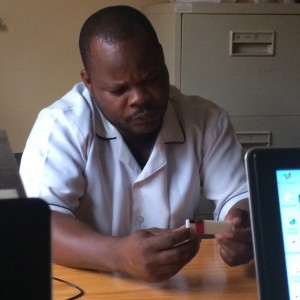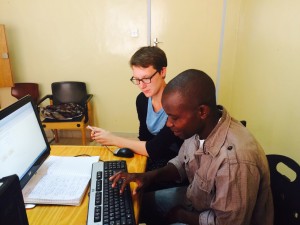Since we’ve been spending a hefty portion of our time at St. Gabe’s in Hospice, I wanted to take a few minutes to introduce you to some of the palliative care team. Because even if I’ve said it before, it definitely bears repeating: the hospital workers are AWESOME! I feel like I’ve been reminded of this in 3 distinct scenarios this week. Yeah, it’s been a busy one, and a particularly Morphine Tracker-heavy one to boot.
Thursday was one of the hospital’s biweekly outpatient palliative care clinics, and we had the opportunity to observe and assist Alex, the palliative care nurse and resident Superman of the Family Centered Care Unit (FCCU). We popped over to the FCCU as soon as morning meeting was over (around 8 AM) and found that the benches outside were already FULL of people. Inside, a line stretched down the wall, all the way to the treatment room. As we met up with Alex, he didn’t even bat an eye at the people cueing up. Instead, he got straight to work. Now, when I say work, I mean it in the truest sense of the word. This guy does everything: read patient records, perform exams, collect vitals, write in the patient’s health passport, provide injections, count pills, dispense medications, schedule follow-up visits, and keep records for the pharmacy staff. That day, he enlisted our services to help pack pills, track down one of the hospital’s 3-4 functional blood pressure cuffs, fill out pharm records, and greet patients (woooo, Chichewa practice). After an endless stream of heart failure, sickle cell, Karposi’s sarcoma, and stroke cases (among others), lunchtime hit and the clinic was finally over. As out last patient shut the door, I couldn’t help but exclaim “Alex, why didn’t you tell us that you’re a SUPERHERO!” The man seriously does it all, and the fact that he can navigate the busy clinic solo and maintain the sensitivity required for hospice care just goes to further highlight his incredible contribution to the hospital.

The second ‘ah ha!’ moment came while we were delivering a presentation on Morphine Tracker. During lunch on Wednesday, we invited the entire palliative care team (a mixture of 8 clinical officers, nurses, and other health care workers) to learn about how our software can improve quality of care for patients with chronic conditions. We overviewed the importance of keeping careful records of morphine use (morphine shortages are common, and the drug is heavily regulated by the Ministry of Health and various nonprofit donors), and then presented Morphine Tracker as a tool to make that process easier. I was encouraged by the fact that 5 team members were in attendance (during lunch, no less!), and that we had some valuable discussion on marrying the system with existing routine. But perhaps the most uplifting moment was when Collins showed up to the meeting. Collins is the first person we’ve trained to use Morphine Tracker, and he has taken to it with remarkable ease and an optimistic attitude. To get why it’s exciting, though, you need to know 2 things about Collins:
- He’s on holiday right now. Collins is actually leaving to visit his family in Zambia next week. But what did he decided to do with his day off ?!? (a day I’d use to eat popcorn and binge watch Netflix): HE CAME TO SUPPORT US!
- Collins is technically on the cleaning staff. He has no medical experience and little computer training. Yet, his superiors recognized his potential (rightly so!) and have designated him as one of our new Morphine Tracker data entry ‘point people’. Despite the fact that he’s comparatively low ranking in the hospital staff, he has adopted his role with Morphine Tracker to such an extent that he feels he has the agency to contribute to meaningful decisions about its use in the hospital. How incredible is that?!?

Our third palliative care superhero is Mary Kaminga, one of the health workers who typically is found in palliative care. Like Collins, Mary hasn’t had extensive computer training to this date. Nonetheless, our first lesson yesterday went swimmingly! After listening with a quiet consideration, Mary would be able to execute the Morphine Tracker commands like she’d been doing it for weeks. We made a fair amount of progress in our 40-minute lesson, and scheduled more tutorials for early next week. I was afraid that our earnest praise of Mary’s work was getting brushed off (she’s incredibly modest). However, my heart did a little dance when Mary stopped us on our way out of the ward that afternoon. “Hey, Mary, we’re just heading to outpatient. Do you need any help?” She spoke shyly, but with a twinkle in her eye. “I just need to learn more”. Mary has a heart of gold, and she and Collins’ dedication bodes well (I hope) for the future of morphine records at St. Gabe’s.
Our experiences with the palliative care team this week have only given me increased respect for some of St. Gabriel’s finest. This insight comes with perfect timing, as we have spent this past week presenting on Morphine Tracker and starting to put it into play for the ward. As we make some final tweaks, the importance of factors like ease of use and ability to quickly integrate the software into existing routines become crystal clear. After all, the superhero’s tools only help them defeat the powers of darkness if they’re handy enough to come into use.